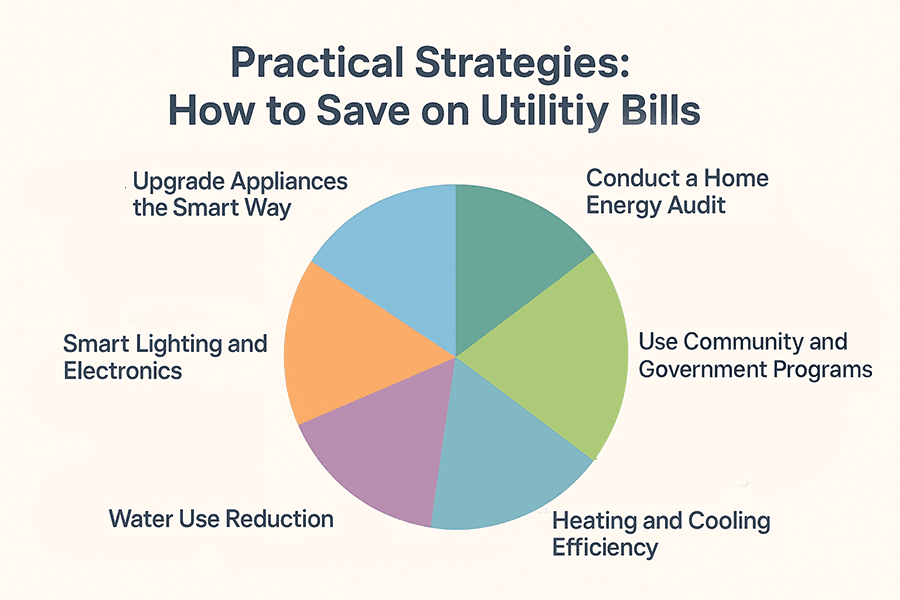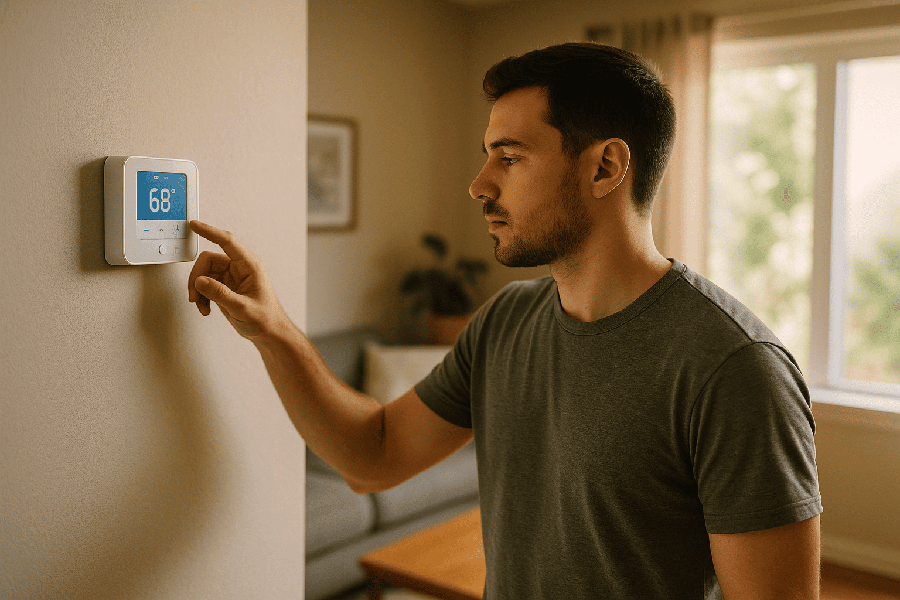Quick Quiz: What’s Your Utility Saving Style?
Answer step by step. Your result will appear at the end.
Utility bills are one of the most consistent expenses in every household budget, yet they are also one of the most underestimated. Many families accept high energy, water, and heating costs as unavoidable, when in fact these bills contain multiple areas where significant savings can be achieved. Learning how to save on utility bills is not about cutting comfort but about applying proven efficiency strategies that lower waste, reduce hidden costs, and create financial breathing room every month.
Rising energy prices, seasonal demand, and outdated household habits have made utility bills a growing burden for millions of Americans. Still, the tools and knowledge to reduce these costs are widely available and straightforward to apply. This guide is written with a professional focus on real-world effectiveness, drawing on tested practices used by households, financial coaches, and government programs. After reading, you will understand not only the reasons behind rising bills but also the most effective ways to take control of them and free up money for savings, debt reduction, or other priorities.
Listen to the article - it is faster than reading!
Why Utility Costs Keep Rising?
Households across the United States have seen utility bills steadily increase over the past decade, and this trend shows no signs of slowing down. Several structural factors contribute to this growth. Energy markets are volatile, and spikes in oil and natural gas prices quickly translate into higher heating and electricity costs for consumers. Seasonal weather extremes add pressure, with hotter summers and colder winters increasing demand for air conditioning and heating. Even small changes in average temperature can drive bills upward significantly, especially in older homes with poor insulation or inefficient systems.
Another factor is infrastructure. Utility providers invest in grid modernization, renewable energy integration, and maintenance of aging pipelines or transmission networks. While these investments are necessary for long-term stability, the costs are often passed directly to consumers through higher rates and fees. Regulatory changes, environmental policies, and regional supply shortages also contribute to uneven price increases that hit certain states or cities harder than others.
Household behavior and technology also play a role. Many homes still rely on outdated appliances, incandescent bulbs, or heating and cooling systems that consume far more energy than modern alternatives. Phantom energy usage - devices plugged in and drawing power even when not in use - quietly inflates monthly bills. Water waste from leaking faucets, inefficient showerheads, or overuse of hot water can add dozens of dollars to a family's expenses without being noticed until the bill arrives.
Finally, there is the challenge of consumption patterns. Remote work has increased daytime energy use, and more devices are constantly connected to home networks. Lifestyle changes that once seemed minor, such as leaving lights on in multiple rooms or running half-empty laundry loads, compound into significant monthly expenses. Understanding these drivers is the first step toward action. Once the mechanics of rising costs are clear, the solutions - ranging from energy audits to behavioral adjustments - become both accessible and practical, giving households control over expenses that previously felt uncontrollable.
Once the mechanics of rising costs are clear, the solutions - ranging from energy audits to behavioral adjustments - become both accessible and practical, giving households control over expenses that previously felt uncontrollable.
We are recommend
Smart Monthly Savings Calculator
Want to know if your savings plan is realistic? Our Smart Savings Calculator shows how much you can set aside each month, how close you are to reaching your goal, and what small changes could accelerate your progress. Built by our financial expert Henry Trent, it explains results in plain language, offers practical tips, and keeps all data private on your device. Try it now and see your financial path with clarity.
Practical Strategies: How to Save on Utility Bills
Reducing utility expenses is not about extreme sacrifices but about applying targeted methods that are proven to work in everyday households. Financial coaches emphasize that large, consistent savings come from system-level improvements - upgrading efficiency, adjusting usage patterns, and leveraging community resources - rather than one-off actions. The goal is to build habits and systems that cut bills automatically while keeping comfort intact. For this reason, each strategy below includes a detailed explanation, practical applications, and an estimate of how much you can realistically save per month.
When evaluating methods, it is important to understand that not every tactic applies equally to every household. Renters, for example, might focus on lighting and electronics, while homeowners benefit more from energy audits and insulation upgrades. What unites all of these approaches is their proven ability to reduce recurring costs month after month. Savings that may look small at first - $20 here, $40 there - quickly compound into hundreds of dollars each year. By combining several strategies, households typically free between $150-$300 per month, creating breathing room in budgets that once felt fixed.

Conduct a Home Energy Audit
(Average savings: $15-$50 per month)
A home energy audit is considered the foundation of effective utility savings. It identifies where energy is wasted - leaky windows, poor insulation, inefficient appliances, or old lighting systems - and provides a roadmap for improvement. Professional audits, offered by many utility companies for free or at a low cost, use tools like blower doors and infrared cameras to locate inefficiencies. DIY audits are also valuable: walking through each room, checking for drafts, inspecting attic insulation, and reviewing energy bills for unusual spikes.
The main advantage of an energy audit is clarity. Without one, households often guess at solutions, spending money on upgrades that may not address the core problem. With audit results, actions can be prioritized by cost and impact. For example, sealing a $5 draft stopper around a door may save $10 monthly during winter, while replacing an outdated refrigerator can save $20-$30 monthly year-round. Audits also highlight “phantom load” issues - electronics that draw power when turned off - that can be solved with smart power strips or unplugging devices.
Benefits of an energy audit include:
- Targeted action: no wasted effort on low-impact changes.
- Measurable savings: immediate reductions visible in monthly bills.
- Long-term guidance: helps plan future upgrades intelligently.
Households that act on audit recommendations typically save $15-$50 per month, depending on the severity of inefficiencies. The upfront effort is small, but the returns are ongoing, making it one of the most efficient entry points for people exploring how to save on utility bills.
Heating and Cooling Efficiency
(Average savings: $25-$75 per month)
Heating and cooling account for nearly half of household energy use, making them the largest target for cost reduction. Inefficiency here drives bills higher than any other factor. Fortunately, several proven strategies deliver measurable savings without reducing comfort. Programmable or smart thermostats automatically adjust temperatures when you are asleep or away, eliminating wasted energy. Sealing windows and doors with weather-stripping prevents warm or cool air from leaking out. Adding insulation to attics and walls reduces the load on HVAC systems, while ceiling fans help circulate air to maintain a consistent temperature with less reliance on heating or cooling units.
Practical examples include setting the thermostat down two degrees in winter and up two degrees in summer, which saves an average of 5-10% on energy bills. A household spending $200 monthly on heating and cooling can cut $20 simply through thermostat management. Upgrading to a smart thermostat like the Nest Learning Thermostat, which learns patterns and optimizes automatically, often reduces costs by $25-$35 monthly. Sealing leaks can save another $10-$15, and ceiling fans add another $5-$10.
Advantages of focusing on heating and cooling include:
- High impact: largest single category of utility expenses.
- Sustainable savings: once insulation or a smart thermostat is installed, benefits repeat monthly.
- Comfort preserved: efficiency changes enhance comfort rather than reduce it.
Altogether, households applying these strategies consistently save $25-$75 per month, proving that managing heating and cooling efficiency is one of the most cost-effective methods for how to save money on utilities.
Water Use Reduction
(Average savings: $15-$40 per month)
Water bills are often overlooked because they appear smaller than electricity or heating, yet waste in this category adds up quickly. Inefficient fixtures, leaks, and high hot-water usage quietly raise costs. A dripping faucet wastes up to 3,000 gallons annually, which equals $5-10 per month on most municipal water bills. Outdated showerheads can use twice the water of modern low-flow versions, raising both water and heating expenses. Washing machines and dishwashers that run half-empty multiply costs unnecessarily.
Practical improvements begin with fixing leaks immediately, replacing showerheads with low-flow models, and installing faucet aerators. Each of these steps requires minimal investment - often less than $20 - but saves $5-15 per month. Hot-water management is another powerful tool. Lowering the water heater thermostat to 120°F reduces energy use while maintaining safe temperatures. Running laundry with cold water is equally effective, cutting heating costs by $5-10 monthly without sacrificing cleaning performance.
Households can also adopt usage habits: shorter showers, waiting for full loads before running dishwashers or washing machines, and avoiding unnecessary outdoor water use. Together, these changes generate substantial savings without lowering quality of life.
Advantages of water-use reduction include:
- Dual savings: lower water bill plus reduced energy for heating.
- Low upfront cost: fixes and replacements are inexpensive.
- Immediate results: savings visible on the next billing cycle.
When combined, these strategies save households $15-$40 per month. For larger families, savings may be even higher, making water efficiency one of the most practical ways for how to save on utilities without requiring major lifestyle changes.
Smart Lighting and Electronics
(Average savings: $10-$30 per month)
Lighting and electronics may not seem like large contributors to utility bills, but inefficient usage creates steady leaks. Traditional incandescent bulbs consume far more electricity than modern LEDs, and leaving lights on in unused rooms multiplies waste. Electronics left plugged in continue to draw power - known as “phantom load” - which accounts for 5-10% of household electricity use.
Switching entirely to LED bulbs is considered one of the fastest returns on investment in home efficiency. Each LED uses 75% less energy and lasts 25 times longer than an incandescent. A household replacing 10 frequently used bulbs can save $10-15 per month. Adding timers or smart plugs ensures lights and devices turn off automatically, preventing unnecessary consumption. Unplugging chargers, game consoles, and TVs when not in use can save another $5-10 monthly.
Practical examples include:
- Using motion-sensor lighting in hallways or outdoor areas.
- Setting smart power strips to cut off electricity to electronics when idle.
- Combining natural light during the day with targeted LED use at night.
Advantages of this approach include:
- Low-cost implementation: most changes require inexpensive upgrades.
- Healthier home: LEDs produce less heat, reducing cooling needs.
- Sustainable: once installed, LEDs and smart devices deliver long-term savings.
By adopting these measures, households consistently save $10-$30 per month, which adds up to $120-$360 per year. This strategy is simple, effective, and central to how to save money on utility bills in a modern home.
Upgrade Appliances the Smart Way
(Average savings: $20-$60 per month)
Outdated appliances drain more energy and water than necessary. Refrigerators, washers, dryers, and dishwashers manufactured over 10 years ago often use double the resources of today's Energy Star-rated models. While the upfront cost of new appliances is higher, the monthly reductions in utility bills make the investment worthwhile.
Energy Star refrigerators, for example, use 15-20% less electricity than standard models. Replacing a 15-year-old refrigerator can save $10-15 per month. High-efficiency washing machines cut water use by 30%, saving $5-10 monthly, while modern dishwashers save both water and energy. Heat pump dryers reduce electricity use significantly, often saving $15-20 per month compared to older electric dryers.
To make upgrades affordable, households can look for rebate programs offered by utilities or state governments. Many provide cash incentives of $50-$200 for replacing inefficient appliances, further improving payback. In some cases, financing programs with zero-interest terms make upgrades accessible even for low-income households.
Advantages of upgrading appliances include:
- Long-term return: appliances last 10-15 years, locking in savings.
- Environmental impact: reduced energy and water consumption lowers carbon footprint.
- Better performance: new models clean more effectively and run more quietly.
Typical savings range from $20-$60 per month, depending on how many appliances are replaced and how outdated the old ones were. This makes smart upgrades one of the most impactful long-term strategies for households focused on how to save money on utilities while also improving daily living conditions.
Use Community and Government Programs
(Average savings: $30-$100 per month)
Many households are unaware of programs designed to lower utility costs directly. Federal, state, and local initiatives provide assistance with heating, cooling, weatherization, and energy efficiency. The Low Income Home Energy Assistance Program (LIHEAP), for example, helps eligible families pay heating and cooling bills. Average support reduces monthly costs by $25-$50. Weatherization programs cover insulation, air sealing, and appliance upgrades, cutting bills by another $20-$40 monthly.
Utility companies also run rebate and efficiency programs. Customers can receive free energy-saving kits (LED bulbs, smart power strips, faucet aerators) or discounts on efficient appliances. Some providers offer budget billing, which spreads annual costs evenly across months, preventing seasonal spikes and reducing financial stress.
Community resources extend savings further. Nonprofit organizations help families apply for benefits, while local housing authorities often partner with utilities to deliver discounted services. These programs are not limited to extreme poverty - they are designed to stabilize working households and prevent debt spirals.
Advantages include:
- Direct savings: support applies immediately to bills.
- Stackable benefits: families can combine multiple programs.
- Accessibility: nonprofit and government guidance makes applications manageable.
Households that fully engage with these programs typically save $30-$100 per month. Exploring these opportunities is essential for families learning how to save on utility costs while maintaining financial stability.
Checklist: Quick Wins to Start Saving Today
Not every step toward lower utility bills requires a major investment or complicated planning. Some of the fastest wins come from simple actions you can take today. These moves are low-cost, highly effective, and instantly visible on your next statement. By focusing on daily habits and small upgrades, you can immediately free up cash that used to slip away unnoticed.
Note: This checklist is designed to be copied, printed, or saved to your notes app. Each item is a practical, immediate action that frees real dollars every month. Pick two or three today and you can already reduce your utility costs by $50-$100 this month.
Success Examples: Households That Saved on Utilities Bills
Myths vs Facts About Saving on Utility Bills
Many households struggle with utility bills not only because of high costs, but also because of misinformation. Myths about saving energy and water often circulate through word of mouth or outdated advice, leading families to waste time on ineffective actions while ignoring strategies that actually work. These myths discourage people from trying, reinforce a sense of helplessness, and in some cases even increase costs instead of reducing them.
Separating fact from fiction is critical for households that want consistent, measurable results.
By understanding what truly impacts bills and what does not, people can focus on changes that pay off quickly and permanently. The table below outlines five of the most common myths and the facts that disprove them, based on practical evidence and professional recommendations.
|
Myth |
Fact |
|
“Turning off lights is enough to save big on electricity.” Many people believe that simply turning off lights when leaving a room will drastically cut their bills. While this habit is positive, it overstates the savings. Lighting accounts for about 10% of household electricity use. Even turning lights off religiously only reduces a small portion of the bill. Believing this myth can make families think they are “doing enough,” while the largest savings opportunities in heating, cooling, and appliances remain untouched. |
Lighting is important, but the biggest savings come from heating, cooling, and major appliances. Upgrading to LED bulbs provides real benefits - about $10-15 per month for an average home - but this is only a starting point. The bulk of savings, often $50-150 per month, comes from thermostat adjustments, sealing leaks, and replacing inefficient appliances. Experts recommend combining lighting improvements with system-level changes to achieve significant reductions. In short, turn lights off, but don't stop there. |
|
“Lowering the thermostat drastically in winter saves more money.” Some households drop their thermostat 10-15°F at once, assuming bigger cuts equal bigger savings. In reality, extreme changes force the heating system to work harder when raising the temperature back up, creating strain and discomfort. Families often abandon the practice quickly, feeling cold and frustrated, with little to show for it. |
Moderate adjustments are far more effective and sustainable. Studies confirm that lowering the thermostat by just 2-3°F in winter reduces heating bills by 5-10%. Paired with a programmable thermostat, this saves $20-30 per month without sacrificing comfort. Insulation and sealing drafts amplify the effect. The fact is that small, consistent changes combined with efficiency upgrades outperform drastic measures that are impossible to maintain. |
|
“Water is cheap, so cutting use doesn't matter.” A common belief is that water bills are too small to justify attention. Families think reducing shower times or fixing leaks won't impact finances. As a result, dripping faucets or outdated showerheads go ignored for years. What looks like a few cents of waste actually compounds into hundreds of gallons - and real money - each month. |
Water efficiency has a measurable financial impact. A single leaky faucet wastes 3,000 gallons annually, costing $5-10 monthly. Installing a $15 low-flow showerhead can cut hot water use enough to save another $10-15. Shortening showers, using cold water for laundry, and waiting for full loads reduce both water and energy costs. Together, these actions often save $20-40 monthly. For households on tight budgets, this amount is significant and worth prioritizing. |
|
“Upgrading appliances is too expensive to ever pay off.” Many families delay replacing old refrigerators, washers, or dryers because of the upfront price. They assume the savings are too small or too slow to justify the investment. In practice, outdated appliances consume far more energy and water, quietly inflating bills every month. This myth keeps households locked into long-term waste. |
Modern Energy Star appliances deliver consistent returns. Replacing a 15-year-old refrigerator can cut $10-15 monthly in electricity. High-efficiency washers reduce water bills by $5-10, and heat pump dryers save $15-20. Over a year, savings often reach $200-400, paying back the initial cost within a few years. Rebates and financing programs reduce barriers further. The fact is that smart upgrades lower bills significantly, improve performance, and provide long-term financial relief. |
|
“Only homeowners can save money on utilities.” Renters often believe they are powerless to change bills because they don't own the property. They assume upgrades like insulation or new appliances are off-limits, so they do nothing. This mindset locks renters into paying higher bills than necessary, month after month. |
Renters have plenty of options to cut costs. Even without structural changes, renters can install LED bulbs, use smart power strips, add draft stoppers, run cold-water laundry, and shorten showers. These low-cost actions save $30-60 monthly. In addition, renters can negotiate with landlords for efficiency upgrades or apply for utility rebates directly. The fact is that renters can achieve meaningful savings with habits and small devices, proving that ownership is not required for financial control. |
Tools & Resources That Really Help You
Saving on utility bills does not depend on guesswork. Reliable tools and resources exist to track usage, identify waste, and secure discounts. These are recommended by financial advisors, widely used by households, and backed by strong consumer reviews. The key is not to use every tool at once, but to pick the ones that fit your household's lifestyle and apply them consistently. Below are proven, trustworthy options that deliver measurable reductions in utility costs.
-
Energy Star
Energy Star is a government-backed program that certifies appliances, lighting, and home products that meet strict efficiency standards. By choosing Energy Star-rated refrigerators, washers, dryers, and HVAC systems, households can cut energy use by 10-30%. For example, replacing an old refrigerator with a certified model can save $10-15 per month in electricity. The Energy Star website also provides calculators, product guides, and rebate information, making it easier to plan upgrades. It's effective because it combines official authority with consumer-friendly tools, ensuring every purchase has a long-term impact on bills. -
Nest Learning Thermostat
The Nest Learning Thermostat is a smart device that optimizes heating and cooling automatically. It learns daily routines, adjusts temperatures when nobody is home, and provides detailed energy reports. Households that switch to a Nest typically save $25-$35 per month on heating and cooling, which adds up to $300 annually. Many utility companies offer rebates or discounts on Nest devices, reducing the upfront cost. It is highly effective because it takes the burden of constant adjustment off the homeowner, delivering both comfort and consistent savings without requiring lifestyle sacrifices. -
Sense Home Energy Monitor
The Sense Energy Monitor connects to your home's electrical panel and tracks usage in real time. It identifies which appliances and devices consume the most electricity, allowing households to make informed adjustments. For example, families discover phantom loads or inefficient appliances they didn't realize were major cost drivers. Savings typically reach $20-40 per month by eliminating wasteful usage. The tool is considered effective because it provides visibility - knowing exactly where electricity goes removes guesswork and empowers precise action. Many energy-conscious homeowners use Sense to achieve lasting bill reductions. -
National Weatherization Assistance Program
The Weatherization Assistance Program (WAP) is a federal initiative that helps low-income households reduce energy costs through insulation, air sealing, and heating/cooling upgrades. Eligible families often receive thousands of dollars in improvements at no cost. Typical savings average $25-60 per month on heating and cooling bills. The program is trusted because it is federally funded, delivered through local agencies, and has a track record of lowering expenses for millions of households. For families under financial pressure, this is one of the most impactful resources available.
FAQ: How to Save on Utility Bills
Q1. How can I reduce my utility bills?
The most effective way to reduce utility bills is to combine small daily habits with structural improvements. Start with quick wins such as switching to LED bulbs, lowering your thermostat by 2°F, and fixing leaks, which together can save $40-60 monthly. For longer-term results, upgrade to Energy Star appliances and consider a smart thermostat that automatically manages heating and cooling. Conducting an energy audit highlights exactly where money is wasted. Finally, explore rebate or assistance programs in your state, as these can cut monthly expenses by another $25-50.
Q2. What is the best way to save money on utility bills quickly?
Quick savings come from attacking the biggest leaks first. Heating and cooling typically make up half of energy costs, so adjusting your thermostat, sealing drafts, and using ceiling fans can reduce bills by $25-50 in the first month. Switching five high-use bulbs to LEDs cuts another $10-15. Fixing a faucet leak saves $8-12. Altogether, these steps can produce $50-100 in savings within weeks. The fastest path is combining easy behavioral changes with low-cost upgrades, ensuring results show up on the very next billing cycle.
Q3. How do I lower electricity bills without major upgrades?
Lowering electricity costs does not always require new appliances or expensive retrofits. Start by eliminating “phantom load” with smart power strips or unplugging idle electronics, saving $10-15 monthly. Replace bulbs with LEDs and use natural light whenever possible, which reduces lighting costs by another $10. Run laundry in cold water and only full loads, saving both electricity and water heating costs. If you have a dishwasher, use the eco setting and skip heated drying. These small, consistent habits lower bills by $30-50 per month without requiring structural changes.
Q4. How can renters save on utilities if they don't own the property?
Renters often believe they are powerless to cut utility bills, but there are several effective strategies. Replace standard bulbs with LEDs, use draft stoppers for doors and windows, and install low-flow showerheads. These inexpensive actions save $20-40 monthly. Renters can also manage usage: turn off lights in unused rooms, unplug devices, and run appliances only with full loads. In some cases, landlords are open to efficiency upgrades if tenants share information on rebates or assistance programs. Renters can realistically reduce costs by $40-70 per month without making permanent property changes.
Q5. What government programs help reduce utility costs?
Several government programs are designed to lower household utility expenses. The Low Income Home Energy Assistance Program (LIHEAP) helps with heating and cooling bills, often reducing monthly costs by $25-50. The Weatherization Assistance Program (WAP) funds insulation, sealing, and efficiency upgrades that can save $20-60 monthly. Many state and local utilities offer rebates for Energy Star appliances or smart thermostats, which accelerate savings further. Nonprofit partners also guide households through applications. Together, these programs ensure that families do not have to manage rising costs alone and can stabilize budgets sustainably.
Q6. Are smart home devices worth it for cutting utility bills?
Smart devices like thermostats, plugs, and energy monitors are highly effective when used consistently. A Nest or Ecobee thermostat can lower heating and cooling costs by $25-35 per month by adjusting temperatures automatically. Smart plugs eliminate phantom energy waste, saving $5-10 monthly. Home energy monitors track exactly where electricity is used, helping households target inefficiencies that save another $15-20. While the upfront cost ranges from $20 to $200 depending on the device, rebates often reduce this. Over time, most smart devices pay for themselves within a year and continue producing savings.
Conclusion
Utility bills may feel like a fixed cost, but they are one of the easiest areas of household spending to control. By applying structured strategies - conducting energy audits, upgrading appliances, improving heating and cooling efficiency, and tapping into community programs - you create measurable, repeatable savings. Even modest adjustments like switching to LEDs, sealing drafts, or running full laundry loads accumulate into $50-$150 per month in freed cash. Over a year, that translates to thousands of dollars that can be redirected toward savings, debt repayment, or essential needs.
The most important takeaway is consistency. A single action lowers one bill, but layering multiple tactics builds a permanent system of efficiency. Real families, from renters in apartments to homeowners in older houses, prove that sustainable reductions are possible without sacrificing comfort.
Start small: copy the checklist, pick one action today, and set aside the money you free into a dedicated account labeled “Utility Savings.” As your balance grows, you’ll see the direct impact of your efforts and build momentum for larger steps. Saving on utility bills is not just about cutting costs - it is about gaining control, creating stability, and giving your household financial breathing room.






